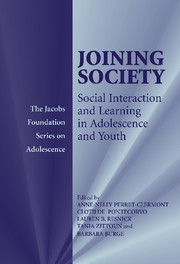Book contents
- Frontmatter
- Contents
- List of Contributors
- Foreword
- Preface
- I Introduction
- II Youth-Constructed Socialization
- III Personal Agency Through Collective Activity
- 8 Learning and Thinking in Adolescence and Youth: How to Inhabit New Provinces of Meaning
- 9 From the Provinces of Meaning to the Capital of a Good Self: Some Reflections on Learning and Thinking in the Process of Growing Adult in Society
- 10 Preapprenticeship: A Transitional Space
- IV Learning in Practice and Discourse
- V Intergenerational Sites for Thinking
- VI Pathways to Adulthood in National Context
- Index
- References
8 - Learning and Thinking in Adolescence and Youth: How to Inhabit New Provinces of Meaning
Published online by Cambridge University Press: 08 January 2010
- Frontmatter
- Contents
- List of Contributors
- Foreword
- Preface
- I Introduction
- II Youth-Constructed Socialization
- III Personal Agency Through Collective Activity
- 8 Learning and Thinking in Adolescence and Youth: How to Inhabit New Provinces of Meaning
- 9 From the Provinces of Meaning to the Capital of a Good Self: Some Reflections on Learning and Thinking in the Process of Growing Adult in Society
- 10 Preapprenticeship: A Transitional Space
- IV Learning in Practice and Discourse
- V Intergenerational Sites for Thinking
- VI Pathways to Adulthood in National Context
- Index
- References
Summary
More than 50 years ago, Kurt Lewin was very conscious of the tremendous task of approaching the multifaceted phenomenon of adolescence and transitions to adulthood. According to Lewin (1951), “The problem of adolescence shows clearly that a way must be found to treat changes, shifts in ideology and group-belongingness within one realm of scientific language in a single realm of discourse or concepts. How can this be done?” (p. 133).
Lewin tried to conceptualize, within the framework of his field theory, some characteristics of this transitional period of life. Instead of treating the issue from an Aristotelian point of view, Lewin proposed (from a Galileian perspective) to engage in a study of situations and instances that show the so-called typical difficulties of adolescent behavior (1951, p. 135). Thus, the transition from childhood to adulthood could be seen as a change in group affiliations, particularly salient in social contexts in which the separation between children's and adults' worlds becomes a crucial feature of the modernity of societies. Moreover, the transition to adulthood can also be considered a situation unfamiliar to adolescents, a region of experience for which they are requested to build up adequate cognitive, social, and emotional tools; a region in which salient questions must be answered: for example, What kind of person does society require me to become? What kind of person would I like to become? What kind of conflict or contradiction arises when coping with these two major questions?
- Type
- Chapter
- Information
- Joining SocietySocial Interaction and Learning in Adolescence and Youth, pp. 119 - 140Publisher: Cambridge University PressPrint publication year: 2003
References
- 1
- Cited by



